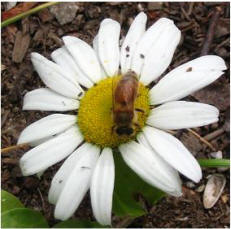Apis mellifera

Interactions
Do honey bees interact with other species such a mutualistic, commensal, parasitic, predatory way? Honey bees have a mutualistic relationship with insect-pollinated flowers, because both species gain from the interaction. Honey bees gain nectar and pollen, while the flowers gain a higher reproductive success because their pollen is personally transported to other flowers of the same species. Honey bees also have a somewhat mutualistic/ commensal with humans because humans take some of the honey from the bees, but also protect the bees and feed the bees corn syrup during the winter and early spring.
Do honey bees provide food for other organisms? Honey bees also end up as food for a number of other organisms including birds, bats, wasps, toads, and even skunks. Skunks wait by the entrance of the hive and eat the guard bees one by one. Birds also eat many foraging honey bees, which may have accidentally flown to close to the birds’ nest. The giant toad, hedgehog, armadillo, and anteater also consume honey bees.
Does it serve as a host for another organism? Honey bees also serve as a host to different types of mites. Varroa mites attach to the honey bee and suck out the bee’s hemolymph, thereby weakening the honey bee, which can eventually lead to death. Another kind of honey bee mite is the Tracheal mite, which gets inside the honey bee’s trachea, laying eggs and reproducing and eventually cuts off the flow of oxygen to the air sacs.
Find out more
about Varroa mites here!